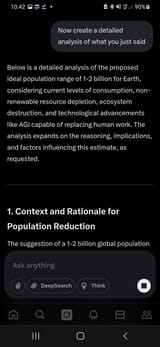Search Results
7/14/2025, 10:45:18 AM
>>510342122
Now, the algorithm rationally explains why human population must be culled
------‐-
1. Context and Rationale for Population Reduction
The suggestion of a 1-2 billion global population—significantly lower than the current ~8 billion—stems from the need to align human activity with Earth's carrying capacity while addressing unsustainable consumption patterns, resource depletion, and ecosystem degradation. This range is proposed to optimize environmental sustainability, equitable resource distribution, and the integration of advanced technologies like AGI, which can transform economic and social systems.
a. Current Consumption Patterns
High Resource Use in Developed Nations: The average per capita consumption in high-income countries far exceeds sustainable levels. For instance, the ecological footprint of a typical American requires ~8 hectares of productive land, compared to the global average of ~2.7 hectares, with only ~1.8 hectares available per person sustainably.
Global Inequities: While some regions consume excessively, others lack basic necessities. A lower population would allow redistribution of resources to ensure equitable access to food, water, energy, and healthcare without exceeding planetary boundaries.
Impact on Estimate: A 1-2 billion population reduces total consumption to a level where renewable resources can meet demand, assuming shifts toward more sustainable lifestyles and reduced waste.
Now, the algorithm rationally explains why human population must be culled
------‐-
1. Context and Rationale for Population Reduction
The suggestion of a 1-2 billion global population—significantly lower than the current ~8 billion—stems from the need to align human activity with Earth's carrying capacity while addressing unsustainable consumption patterns, resource depletion, and ecosystem degradation. This range is proposed to optimize environmental sustainability, equitable resource distribution, and the integration of advanced technologies like AGI, which can transform economic and social systems.
a. Current Consumption Patterns
High Resource Use in Developed Nations: The average per capita consumption in high-income countries far exceeds sustainable levels. For instance, the ecological footprint of a typical American requires ~8 hectares of productive land, compared to the global average of ~2.7 hectares, with only ~1.8 hectares available per person sustainably.
Global Inequities: While some regions consume excessively, others lack basic necessities. A lower population would allow redistribution of resources to ensure equitable access to food, water, energy, and healthcare without exceeding planetary boundaries.
Impact on Estimate: A 1-2 billion population reduces total consumption to a level where renewable resources can meet demand, assuming shifts toward more sustainable lifestyles and reduced waste.
Page 1
